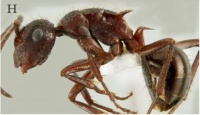Polyrhachis isolata
| Polyrhachis isolata | |
|---|---|

| |
| Scientific classification | |
| Kingdom: | Animalia |
| Phylum: | Arthropoda |
| Class: | Insecta |
| Order: | Hymenoptera |
| Family: | Formicidae |
| Subfamily: | Formicinae |
| Tribe: | Camponotini |
| Genus: | Polyrhachis |
| Subgenus: | Hagiomyrma |
| Species group: | schenckii |
| Species: | P. isolata |
| Binomial name | |
| Polyrhachis isolata Kohout, 2013 | |
Nothing is known about the biology of Polyrhachis isolata.
Identification
A member of the schenckii species-group in the Polyrhachis subgenus Hagiomyrma. Kohout (2013) - With its distinct reddish-brown colour scheme and short, bristle-like pilosity, P. isolata resembles Polyrhachis lachesis and Polyrhachis schenckii. It differs from both in the outline of the pronotal humeri, the orientation of the propodeal spines and the body sculpturation. In P. isolata the lateral pronotal margins are narrowly rounded with the humeri indicated by poorly defined blunt angles, and the pronotal dorsum widest near its midlength. The pronotal dorsum in both other species is distinctly widest across the humeri, with the lateral pronotal margins strongly posteriorly converging. In P. lachesis, the humeri are produced into distinctly dilated, rounded, dorsally shallowly concave prominences, while in P. schenckii the humeri are bluntly angular. In P. isolata, the propodeal spines in profile are oblique to the main axis of the body, while in the other two species they are more-or-less horizontal. The sculpturation of the head and mesosomal dorsum consists of a relatively fine, somewhat vermiculate-rugose pattern, superimposed over irregularly spaced, shallow and rather polished punctures. In both the other species the head and body are finely reticulate-punctate. The gaster in P. isolata and P. lachesis is very smooth, highly polished, while in P. schenckii the gastral dorsum is finely shagreened with relatively abundant, closely appressed pubescence.
Keys including this Species
Distribution
Latitudinal Distribution Pattern
Latitudinal Range: -15.53333333° to -15.53333333°.
| North Temperate |
North Subtropical |
Tropical | South Subtropical |
South Temperate |
- Source: AntMaps
Distribution based on Regional Taxon Lists
Australasian Region: Australia (type locality).
Distribution based on AntMaps
Distribution based on AntWeb specimens
Check data from AntWeb
Countries Occupied
| Number of countries occupied by this species based on AntWiki Regional Taxon Lists. In general, fewer countries occupied indicates a narrower range, while more countries indicates a more widespread species. |

|
Estimated Abundance
| Relative abundance based on number of AntMaps records per species (this species within the purple bar). Fewer records (to the left) indicates a less abundant/encountered species while more records (to the right) indicates more abundant/encountered species. |

|
Biology
Castes
Known only from the worker caste.
Nomenclature
The following information is derived from Barry Bolton's Online Catalogue of the Ants of the World.
- isolata. Polyrhachis (Hagiomyrma) isolata Kohout, 2013: 557, figs. 11G-H (w.) AUSTRALIA.
Unless otherwise noted the text for the remainder of this section is reported from the publication that includes the original description.
Description
Worker
Holotype: TL c. 6.40; HL 1.72; HW 1.40; CI 81; SL 1.72; SI 123; PW 1.06; MW 0.53; PMI 200; MTL 2.03. Mandibles with 5 blunt teeth of equal length. Anterior clypeal margin with median, denticulate flange. Clypeus with very strongly raised median carina; virtually straight in profile, posteriorly rounding into well impressed basal margin. Frontal triangle indistinct. Frontal carinae sinuate with moderately raised margins; central area relatively wide, with distinctly anteriorly raised, longitudinal ridge replacing frontal furrow. Sides of head in front of eyes converging towards mandibular bases in weakly convex line; behind eyes, sides widely rounding into convex occipital border. Eyes convex, clearly exceeding lateral cephalic outline in full face view. Ocelli lacking. Pronotal humeri only narrowly rounded with indication of blunt angles; pronotal dorsum widest just behind humeri; promesonotal suture distinct. Mesonotal lateral margins distinctly converging into laterally distinct, medially somewhat obscure metanotal groove. Propodeum with subparallel lateral margins terminating in sinuate, acute spines with tips curved outwards. Petiole armed with very slender, divergent, acute spines; posterior face of petiole obliquely descending towards base in straight line. Anterior face of first gastral tergite straight at base, rounding onto dorsum.
Mandibles at bases with very fine, rather flat, longitudinal striae and a few, shallow pits, rather polished towards masticatory borders. Clypeus reticulate-punctate, sculpture somewhat wrinkled and obliquely directed towards median carina. Head reticulate-punctate, reticulae more longitudinally organised on sides and between eyes and frontal carinae. Sculpturation on vertex of head and mesosomal dorsum forming rather irregular, more-or-less vermiculate pattern that is superimposed over irregularly spaced, shallow punctures, giving dorsum somewhat polished appearance. Sides of mesosoma and posterior face of petiole reticulate; spines, anterior face and dorsum of petiole rather smooth and polished; gaster highly polished.
Mandibles with a few, relatively short, golden hairs. Anterior clypeal margin with several, very short setae medially and laterally. Head, mesosoma and petiole with numerous, bristle-like, short and medium length hairs, many hairs fringing lateral outline of head; appendages, including antennal scapes, with very short to medium length, erect hairs. Gaster with abundant, posteriorly inclined, golden hairs, longest more than half greatest diameter of eyes. Very sporadic, short, appressed pubescence on sides of mesosoma, petiole, coxae and venter of gaster; pubescence virtually absent from all dorsal suraces.
Distinctly light to medium reddish-brown; mandibular teeth and outer borders, anterior and basal margins of clypeus, frontal carinae, occipital margin, pronotal, mesonotal and mesopleural margins very narrowly lined with black.
Type Material
- Holotype, worker, North Islet, West I., Sir Edward Pellew Group, Northern Territory, Australia, 15°32′0″S 136°31′0″E / 15.533333°S 136.516667°E, 20.iv.1976, J.E. Feehan, Australian National Insect Collection.
Etymology
Derived from the neo-Latin word isolatus, meaning detached in reference to the species rather isolated occurrence on North Islet, West Island.
References
References based on Global Ant Biodiversity Informatics
- Kohout R.J. 2013. Revision of Polyrhachis (Hagiomyrma) Wheeler, 1911 (Insecta: Hymenoptera: Formicidae: Formicinae). Memoirs of the Queensland Museum Nature 56: 487577
